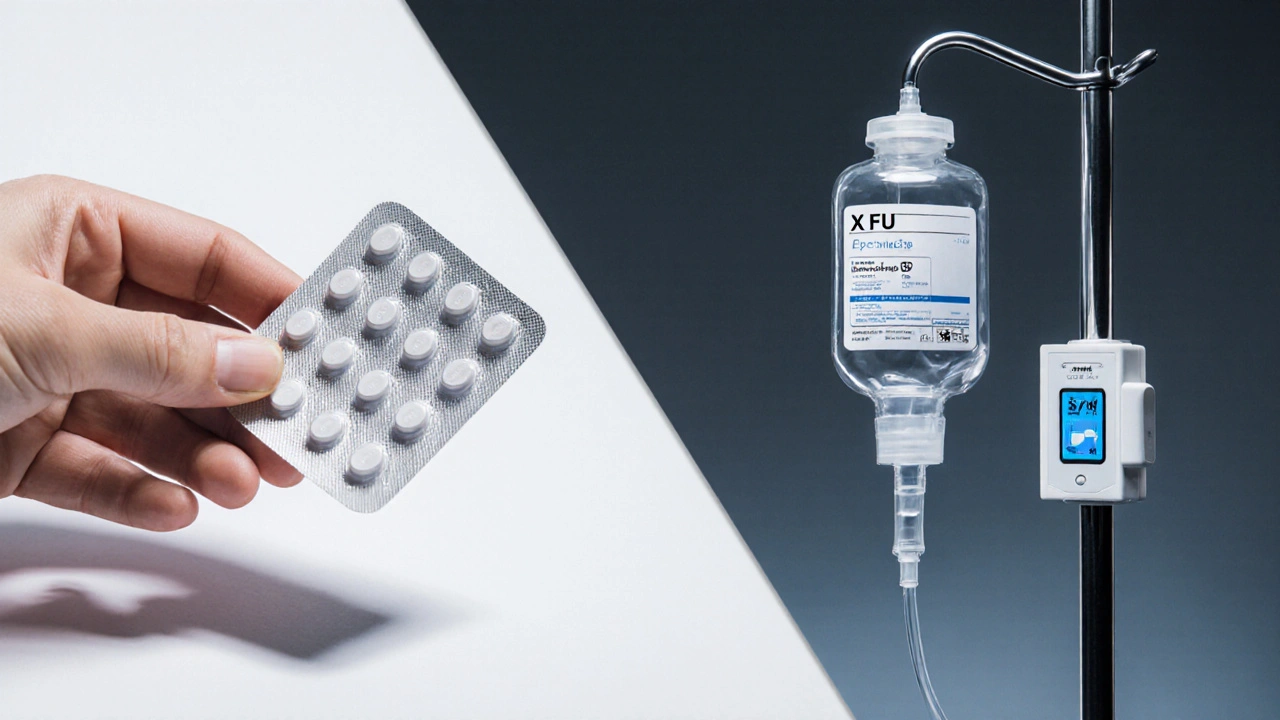Xeloda vs Alternative Cancer Drugs Comparison Tool
An oral fluoropyrimidine that mimics IV 5-FU but offers convenience and a different side-effect profile.
Classic IV fluoropyrimidine with long-standing use in colorectal and gastric cancers.
Oral combination with tegafur, gimeracil, and oteracil for enhanced efficacy and reduced toxicity.
Oral combination for refractory metastatic colorectal cancer after standard treatments.
Simple oral pro-drug combination with lower GI protection compared to S-1.
Choose Xeloda when:
- You need home-based oral dosing
- You can tolerate hand-foot syndrome
- The tumor responds to fluoropyrimidines
- Cost is a concern (generic option available)
- Renal function is adequate
Consider Alternatives when:
- Hand-foot syndrome is problematic
- High neutropenia risk is a concern
- IV access is preferred
- Cost is not a primary factor
- Alternative regimens show better efficacy
Key Takeaways
- Xeloda is an oral fluoropyrimidine that mimics IV 5‑Fluorouracil (5‑FU) but offers convenience and a different side‑effect profile.
- Major alternatives include IV 5‑FU, Tegafur‑based combos, Trifluridine/Tipiracil (Lonsurf) and the oral mixture S‑1.
- Choose Xeloda when you need a home‑based regimen, can tolerate hand‑foot syndrome, and the tumor is known to respond to fluoropyrimidines.
- Cost, toxicity, and drug‑interaction potential often tip the balance toward one alternative or another.
- Discuss dosage adjustments, supportive care, and insurance coverage with your oncology team before switching.
When a doctor mentions "Xeloda" you might wonder how it really stacks up against other chemo options. The answer isn’t a simple yes‑or‑no; it depends on how the drug works, what cancers it treats, how you take it, and what side effects you can handle. This guide breaks down Xeloda (Capecitabine) and the most common alternatives, giving you the facts you need to talk confidently with your care team.
What is Xeloda (Capecitabine)?
Xeloda (generic name Capecitabine) is an oral chemotherapy pill approved in 1998 for metastatic colorectal cancer and later for breast cancer. It belongs to the fluoropyrimidine family, meaning it is chemically related to the classic IV drug 5‑Fluorouracil (5‑FU). The pill is designed to be absorbed through the gut, travel to the liver, and then be converted into 5‑FU right where the tumor sits.
Capecitabine is a pro‑drug that undergoes enzymatic activation by thymidine phosphorylase, an enzyme that is often over‑expressed in cancer tissue. This targeted conversion allows higher concentrations of the active drug inside tumors while keeping systemic exposure lower than a direct IV infusion of 5‑FU.
How Xeloda Works: Mechanism of Action
Once inside the tumor, Capecitabine is turned into 5‑FU, which then interferes with DNA synthesis in two ways:
- It blocks thymidylate synthase, an enzyme needed to make the DNA building block thymidine.
- It incorporates fraudulent nucleotides into RNA, disrupting normal protein production.
The dual attack prevents cancer cells from dividing, leading to cell death. Because the drug is activated preferentially in tumor tissue, patients often experience a different side‑effect mix compared with straight IV 5‑FU.
Typical Indications and Real‑World Efficacy
In large phase‑III trials, Xeloda showed overall response rates of 20‑30% in metastatic colorectal cancer when combined with oxaliplatin (the XELOX regimen). For HER2‑negative metastatic breast cancer, the addition of Capecitabine to taxanes improved progression‑free survival by roughly 2.5 months.
Real‑world registries confirm these numbers, especially when patients stick to the prescribed 2‑weeks‑on/1‑week‑off schedule. Non‑adherence, often caused by hand‑foot syndrome, can drop efficacy by up to 15%.

Major Alternatives to Xeloda
Not every patient can use an oral pill, and some cancers respond better to other fluoropyrimidines. Below are the five most frequently compared drugs, each introduced with a short definition and key attributes.
5‑Fluorouracil (5‑FU)
5‑Fluorouracil is an intravenous (IV) fluoropyrimidine that has been a backbone of colorectal and gastric cancer regimens since the 1950s. It delivers the active drug directly into the bloodstream, bypassing the need for metabolic activation. Typical dosing schedules include a continuous infusion over 48hours or a bolus injection every week.
Tegafur‑Based Combinations (e.g., S‑1, UFT)
Tegafur is another oral pro‑drug that converts to 5‑FU in the liver. It is often combined with modulators such as uracil (UFT) or gimeracil and oteracil (S‑1) to improve efficacy and reduce toxicity. S‑1, approved in Japan and some Asian markets, includes two additional agents that inhibit 5‑FU breakdown and protect the gut lining.
Trifluridine/Tipiracil (Lonsurf)
Trifluridine/Tipiracil (brand name Lonsurf) is an oral combination that works differently from classic fluoropyrimidines. Trifluridine is incorporated directly into DNA, while tipiracil prevents its rapid degradation, allowing sustained exposure. It is approved for refractory metastatic colorectal cancer after failure of standard fluoropyrimidine, oxaliplatin, and irinotecan.
S‑1 (Teysuno)
S‑1 blends tegafur (a 5‑FU pro‑drug) with gimeracil (a dihydropyrimidine dehydrogenase inhibitor) and oteracil (a gastrointestinal protector). This trio yields higher tumor concentrations of 5‑FU while limiting gut toxicity. It’s widely used in East Asian gastric‑cancer protocols and is gaining traction in Western trials.
Other Oral Fluoropyrimidines (e.g., UFT)
UFT pairs tegafur with uracil in a 1:4 ratio, offering a simpler formulation than S‑1 but with less protection against GI side effects. It’s primarily used in Japan for colorectal and gastric cancers.
Side‑Effect Profiles: What to Expect
Each drug shares some common toxicities-hand‑foot syndrome, diarrhea, and myelosuppression-but the frequency and severity differ.
| Drug | Hand‑Foot Syndrome | Diarrhea (grade≥2) | Neutropenia (grade≥3) | Typical Onset |
|---|---|---|---|---|
| Xeloda | 15‑30% | 10‑20% | 5‑10% | 2-3weeks |
| 5‑FU (IV) | 5‑10% | 15‑25% | 15‑25% | Within 1week (continuous infusion) |
| Tegafur‑UFT | 5‑12% | 12‑18% | 8‑12% | 3-4weeks |
| Lonsurf | 3‑8% | 20‑30% | 10‑15% | 4-6weeks |
| S‑1 | 4‑9% | 10‑16% | 12‑18% | 2-3weeks |
Notice that Xeloda’s highest‑grade neutropenia rates are lower than IV 5‑FU, but its hand‑foot syndrome risk is noticeably higher. If a patient’s occupation involves a lot of manual work, hand‑foot toxicity may become a deciding factor.
Decision Criteria: When to Pick Xeloda
- Convenience: Home‑based oral dosing avoids frequent clinic visits.
- Prior exposure to 5‑FU: If a patient tolerated IV 5‑FU well, Xeloda usually offers similar efficacy with a different side‑effect mix.
- Renal function: Capecitabine is cleared by the kidneys; dose reductions are required when creatinine clearance < 30mL/min.
- Hand‑foot tolerance: Patients prone to skin issues may benefit more from IV 5‑FU or S‑1.
- Cost and insurance: In many countries Xeloda is covered under oncology formularies, but generic capecitabine may be cheaper.
Pros and Cons of Xeloda
Pros
- Oral administration simplifies scheduling.
- Lower neutropenia risk than continuous‑infusion 5‑FU.
- Proven efficacy in both colorectal and breast cancer.
- Combination flexibility - works well with oxaliplatin, irinotecan, and targeted agents.
Cons
- Hand‑foot syndrome can be dose‑limiting.
- Requires strict adherence; missed doses drop effectiveness.
- Renal clearance mandates dose adjustment for impaired kidneys.
- Some patients experience severe mucositis or nausea.

Cost Comparison (2025 US Dollar Estimates)
| Drug | Monthly Cost (US$) | Insurance Coverage (Typical) |
|---|---|---|
| Xeloda (brand) | ≈1,200 | 80‑90% |
| Generic Capecitabine | ≈350 | 80‑90% |
| 5‑FU (IV infusion) | ≈1,800 (including infusion center fees) | 70‑85% |
| Lonsurf | ≈2,200 | 65‑75% |
| S‑1 | ≈900 (imported) | 60‑70% |
Prices vary by country and insurance plan, but generic capecitabine remains the most economical oral option. IV 5‑FU can become pricey once infusion center costs are added.
How to Talk to Your Oncologist
Armed with the facts, ask specific questions:
- "Given my kidney function, how should the dose be adjusted?"
- "If I develop hand‑foot syndrome, can we switch to IV 5‑FU or S‑1?"
- "What supportive medications (e.g., pyridoxine) can reduce skin toxicity?"
- "Is my insurance likely to cover the brand versus generic version?"
Document any side effects promptly; dose reductions often prevent treatment interruptions.
Next Steps / Troubleshooting
If you start Xeloda and notice early skin changes, try these steps before contacting the clinic:
- Apply a thick moisturizer after bathing, avoiding scented products.
- Use cooling packs on palms and soles for 15‑20minutes, three times daily.
- Reduce any concurrent vitaminA or retinoid use, as they can worsen the rash.
- If symptoms reach grade2 (painful or interfering with daily activities), call the oncology nurse line for a possible dose pause.
For persistent diarrhea, increase oral rehydration solutions and consider loperamide early. Never halt treatment without medical guidance.
Frequently Asked Questions
Can I take Xeloda and 5‑FU together?
No. Xeloda is a pro‑drug that becomes 5‑FU inside the body. Giving both would cause an overdose of the same active compound and dramatically increase toxicity.
Is Xeloda safe for patients over 70?
Older patients can use Xeloda, but dose reductions of 25‑30% are common if renal function declines or if they have a history of severe hand‑foot syndrome.
How does the efficacy of Xeloda compare to Lonsurf in refractory colorectal cancer?
Lonsurf is approved specifically after failure of fluoropyrimidine‑based regimens, including Xeloda, and typically yields a modest overall survival gain of 1.8months versus best supportive care. Xeloda is usually given earlier in the treatment line, so direct head‑to‑head data are limited.
What supportive medication reduces hand‑foot syndrome?
Pyridoxine (vitaminB6) at 100mg daily has shown modest benefit, and topical urea-lactate creams provide symptom relief. Early dermatology referral is advisable for grade2-3 lesions.
Are there food restrictions while on Xeloda?
No strict restrictions, but a high‑fat meal can delay drug absorption and increase peak concentrations, potentially worsening toxicity. Take the pills on an empty stomach or with a light snack, as directed by your oncologist.

Comments (10)
Alec McCoy
October 9, 2025 AT 11:53
When you’re weighing Xeloda against the other fluoropyrimidines, start by mapping your personal priorities onto the decision matrix the guide provides. If you value the convenience of taking a pill at home, the oral nature of capecitabine is a clear win, but you have to be ready for the hand‑foot syndrome that shows up in about a quarter of patients. On the other hand, if you have a strong support system that can handle frequent infusion visits, an IV 5‑FU regimen might spare you that particular skin toxicity at the cost of higher neutropenia risk. Remember that renal function plays a starring role; a creatinine clearance below 30 mL/min forces a dose reduction no matter which drug you pick, and that can blunt efficacy across the board, and cost is another axis that cannot be ignored-the generic capecitabine pill can be dramatically cheaper than an infusion‑center‑based 5‑FU course, yet insurance formularies sometimes make the branded version look more affordable on paper. When you consider tumor biology, note that capecitabine relies on thymidine phosphorylase, which is often over‑expressed in colorectal tumors, giving you a pharmacodynamic advantage in that setting. Conversely, Lonsurf is designed for refractory disease, so its place in therapy is usually after you’ve exhausted both Xeloda and classic 5‑FU‑based combos. Side‑effect management is also a shared responsibility: proactive moisturizers, pyridoxine supplementation, and early reporting of diarrhea can keep you on schedule and prevent dose interruptions. If you anticipate a busy work schedule, the two‑weeks‑on/one‑week‑off cycle of capecitabine gives you a predictable rhythm that can be synced with personal commitments. For patients over 70, a modest 25 % dose reduction is often recommended, especially when kidney function declines, and the safety data suggest that older adults tolerate the oral route reasonably well. Finally, always bring a printed copy of the cost comparison to your oncology visit; having concrete numbers helps you negotiate with insurers and avoid surprise bills. In short, align the drug’s pharmacology, toxicity profile, administration logistics, and price with your life circumstances, and you’ll make a decision you can stick to.
Aaron Perez
October 11, 2025 AT 13:53
Consider the philosophical underpinnings of treatment choices; does one not, in essence, gamble with the very architecture of cellular replication, and yet, paradoxically, seek mastery over a process that is itself governed by stochastic molecular events? The cascade of enzymatic activations that converts capecitabine into 5‑FU is a micro‑cosmic drama, a ballet of thymidine phosphorylase and dihydropyrimidine dehydrogenase, each step a potential point of failure, each point a lever for therapeutic leverage. One could argue that the oral route is a democratic emancipation from the sterile confines of the infusion suite, yet the same democratization brings forth the specter of non‑adherence-a silent adversary that erodes efficacy. Moreover, the economic calculus is riddled with hidden variables; insurance rebates, pharmacy benefit manager negotiations, and regional pricing discrepancies render any simple cost comparison a mirage. Ultimately, the patient must navigate this labyrinth with both empirical data and existential humility, acknowledging that certainty is a luxury the oncologic universe rarely grants.
William Mack
October 13, 2025 AT 15:53
Xeloda’s oral dosing fits a busy lifestyle, but keep an eye on hand‑foot symptoms early to avoid dose cuts.
Evan Riley
October 15, 2025 AT 17:53
What most people don’t see is that the pharmaceutical pricing model is deliberately opaque, engineered to keep patients dependent on high‑margin IV regimens like 5‑FU while downplaying cheaper oral options. The data tables in the guide are clean, but behind them lies a network of rebate agreements that inflate the apparent cost of capecitabine in certain markets. If you follow the money, you’ll notice that the same insurers that push IV therapy also own stakes in infusion center chains, creating a conflict of interest that skews prescribing habits. This isn’t a random coincidence; it’s a systematic effort to lock patients into a cycle of costly visits, repeated lab work, and scheduled appointments that generate revenue at every turn. Being aware of this hidden agenda empowers you to ask tougher questions and demand transparent pricing before you sign on the dotted line.
Nicole Povelikin
October 17, 2025 AT 19:53
i guess the guide is fine but its just a fluff , why u even need all those tables when u can just ask ur doc . not every one needs a deep dive .
Michelle Weaver
October 19, 2025 AT 21:53
Capecitabine provides a convenient oral alternative with comparable efficacy to intravenous 5‑FU in many colorectal protocols 😊 the side‑effect profile favors lower neutropenia but higher hand‑foot incidence patients should be counseled on skin care strategies the cost advantage of generic formulations can be substantial especially for those with high deductible plans 👍
John Keough
October 21, 2025 AT 23:53
Both oral and IV options have a place in therapy; the key is matching the drug’s strengths to the patient’s situation. If someone can manage daily pills and monitor skin toxicity, capecitabine offers flexibility and often lower overall costs. Conversely, when hand‑foot syndrome is a deal‑breaker or adherence is a concern, IV 5‑FU or even Lonsurf in later lines may be preferable. Discussing these trade‑offs openly with the oncology team ensures that the chosen regimen aligns with personal preferences, comorbidities, and insurance coverage. Ultimately, shared decision‑making leads to better adherence and outcomes.
Graham Smith
October 24, 2025 AT 01:53
The table headings misuse “cost” as “Cost:” which isn’t consistent with the other entries; also “monthly cost” should be capitalised for uniformity. Small errors like these can distract readers from the core data and should be cleaned up in a final edit.
Jeremiah Morgan
October 26, 2025 AT 03:53
It is encouraging to see such a thorough comparison; the detailed side‑effect breakdown will surely aid patients in making informed choices. Remember that every individual response varies, and ongoing communication with your care team remains paramount. Stay hopeful and proactive, and you will navigate the treatment journey with confidence.
nina greer
October 28, 2025 AT 05:53
A final note: the analysis neglects emerging biomarkers that could further refine drug selection.